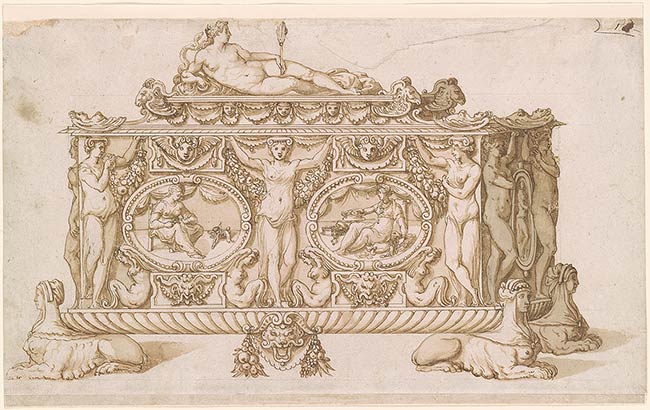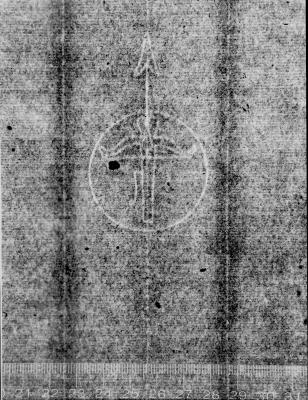
Voyager Record ID: 142651 Accession Number: 1964.3 Artist: Jacopo Strada, ca. 1515-1588, Circle of Title: Design for a Casket with Figure of Prudence at Top Date: ca. 1562-1565 Associated Names: Francesco Salviati (1510-1563) Watermark info: Crossbow in a circle surmounted by an arrow (Briquet 759, Rome 1562-63) Bibliography: Hayward 1962, 163; Fellows Report 1967, 102-03; Hayward 1976, 346; Mortari 1992, 240-41, no. 405; Rome and Paris 1998, 37, 248, no. 95, 250, no. 96; Prosperi Valenti Rodinò, in Rome 2001, 413-14. Descriptive text:
Long associated with Francesco Salviati, this design for a casket surmounted by Prudence, which exists in several versions, may be connected to the circle of Jacopo Strada and his son, Ottavio.
Several compilations of related drawings for decorative arts have been connected to Ottavio Strada. J. F. Hayward drew attention to a now-lost codex of eighty-two drawings for decorative arts, known through an 1869 facsimile, which contained an inscription on its title page attributing the contents to Ottavio and dating them to 1597.1 A similar codex survives at the Fitzwilliam Museum, Cambridge.2 Of the one hundred sheets in the Cambridge codex, thirty-three match designs in the Viennese compilation, with a further two sheets being similar with slight variations.3 Another bound collection of similar drawings with a traditional attribution to Giulio Romano is now in the Victoria & Albert Museum, London.4 As Hayward pointed out, these drawings – like those in Vienna – were once owned by Rudolph II and may have entered the imperial collection via Jacopo Strada, Court Antiquary from 1563-79, or Ottavio who, as noted in the Viennese inscription, was also in the Emperor’s service.5 In his introduction to the seventh volume of Sebastiano Serlio’s architectural treatise, published in Frankfurt in 1573, Jacopo Strada claims that he purchased all of Giulio Romano’s drawings from his son, Raffaello.6 The claim has not been proven but remains plausible in light of the drawings’ connection to Giulio’s designs. As Phillip Pouncey first noted, eight of the drawings in the Fitzwilliam Codex copy originals by or attributable to Giulio Romano in the British Museum.7
Yet another collection of drawings for the decorative arts and connected with the Strada workshop has recently come to light. It was exhibited at Serge Sorokko Gallery, San Francisco, in 2007 and auctioned at Sotheby’s, New York, in 2010. The sheets contain four types of watermarks, which were identified as Italian in origin, dating from the late 1540s or the 1550s, several decades earlier than those associated Fitzwilliam and Viennese codices.9 Among the drawings is another version of the Morgan’s casket with Prudence.8 The same casket design is also known in a third version, now in the Nasjonalgalleriet, Oslo.10
These drawings are all plausibly related to the circle of Jacopo and Ottavio Strada. However, the original source of the presumed copies remains unclear. Though some of the drawings ascribed to Ottavio Strada reveal the influence of Giulio Romano, others, such as the Morgan study, reflect the visual language of other artists. Catherine Monbeig Goguel, for instance, suggested that the Morgan sheet is a copy after the Oslo study, both of which, she argued, reflect a lost design by Salviati.11 Hayward noted that the Morgan drawing is similar in design to the Farnese casket, now in the Museo e Gallerie Nazionali di Capodimonte, Naples, which was, according to Vasari, designed by Perino del Vaga and others and the rock crystals carved by Giovanni Bernardi and Manno Sbarri.12 In his introduction to Serlio’s text, Strada also claims to have purchased all of Perino del Vaga’s drawings from his widow Caterina.13
Footnotes
- “Libro di dissegni per far Vasella da Argento et Oro per servitio della Credenza e tauola per un gran Principe fatte tutte al modo antico, et come anche hoggi usano in Roma. Dissegnati di mao propria di Ottavio Strada, Cittadino Romano et Gentilhuomo della Casa di Rodulpho II Imp. I597.” See Hayward 1970, 10.
- Fitzwilliam Museum, Cambridge, inv. P.D.6-1948. See Hayward 1970, 10-14; Hayward 1976, 24-25, 137.
- Hayward 1970, 13.
- Victoria & Albert Museum, London, inv. 8951. Another codex of drawings in the Bayerische Staatsbibliothek, Munich, contains an inscription to Jacopo Strada, but Hayward has argued that the drawings are instead by Erasmus Hornick. See Hayward 1968, 201-207. For another codex in the manner of Giulio in the Kunstbibliotek, Berlin, see Hayward 1972, 378-86.
- Hayward 1976, 137.
- Serlio 1575, unpaginated introduction: “Hor partendomi di Roma per ritornarmene in Alemagna, passai per Mantova, et andai a reveder Raffaello che fu figliolo di Giulio Romano… non mi fu molto difficile l’impatronirmi di tutti li disegni che furono di suo padre, a lui lassati; dove erano raccolte le più belle cose che havesse Raffael d’Urbino già stato suo maestro: oltre poi a quelle di sua mano: e massime di cose d’architettura, tanto antiche che moderne. E convenuti del prezzo, gliele pagai.”
- Pouncey and Gere 1962, 71.
- Sotheby’s, New York, 27 January 2010, 51, note 9.
- San Francisco 2007, 26-27; Sotheby’s, New York, 27 January 2010, lot 41.
- Nasjonalgalleriet, Oslo, inv. NG.K&H.B.15430.
- Monbeig Goguel, in Rome and Paris 1998, 36-37.
- Vasari 1878-85, 5: 373-74; Hayward 1962, 164.
- Serlio 1575, unpaginated introduction: “…andai à vistar Madonna Catharina, che già fù moglie di Pierino del Vagha pittore del papa…E discorrendo con ella delle robbe del suo marito morto, la trouai disposta di voler vendere tutti li suoi disegni più presto à me…”
Inscribed in upper right corner, in pen and brown ink, "18- (? second digit covered by ink stain)"; on verso, at upper left, in graphite, "62 (encircled)"; at upper center, in graphite, "5".
Watermark: Crossbow in a circle, surmounted by an arrow, centered on chain line (Briquet 759: Rome, 1562/63).
Salviati, Francesco, 1510-1563, Workshop of, Formerly attributed to.
Perman, Einar, 1893-1976, former owner.
Selected references: Hayward 1962, 163; Fellows Report 1967, 102-03; Hayward 1976, 346; Mortari 1992, 240-41, no. 405; Rome and Paris 1998, 37, 248, no. 95, 250, no. 96; Prosperi Valenti Rodinò, in Rome 2001, 413-14.
Adams, Frederick B., Jr. Fourteenth Annual Report to the Fellows of the Pierpont Morgan Library, 1965 & 1966. New York : Pierpont Morgan Library, 1967, p. 102.
Pierpont Morgan Library. Review of Acquisitions, 1949-1968. New York : Pierpont Morgan Library, 1969, p. 169.

